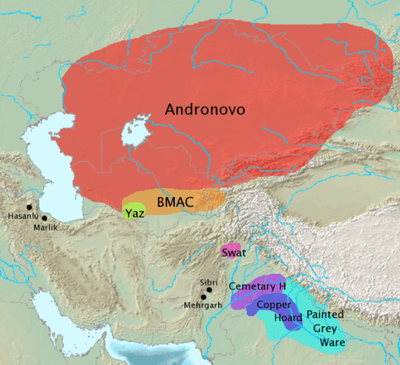Gandhara grave culture


| Outline of South Asian history History of Indian subcontinent | ||||||||||||||||||||||||||||||||||||||||||||||||||||||
|---|---|---|---|---|---|---|---|---|---|---|---|---|---|---|---|---|---|---|---|---|---|---|---|---|---|---|---|---|---|---|---|---|---|---|---|---|---|---|---|---|---|---|---|---|---|---|---|---|---|---|---|---|---|---|
|
Soanian people (500,000 BP)
|
||||||||||||||||||||||||||||||||||||||||||||||||||||||
|
Stone Age (50,000–3000 BC)
|
||||||||||||||||||||||||||||||||||||||||||||||||||||||
|
Bronze Age (3000–1300 BC)
|
||||||||||||||||||||||||||||||||||||||||||||||||||||||
|
Iron Age (1200–26 BC)
|
||||||||||||||||||||||||||||||||||||||||||||||||||||||
|
Classical period (21–1279 AD) |
||||||||||||||||||||||||||||||||||||||||||||||||||||||
|
Late medieval period (1206–1596)
|
||||||||||||||||||||||||||||||||||||||||||||||||||||||
|
Early modern period (1526–1858)
|
||||||||||||||||||||||||||||||||||||||||||||||||||||||
|
Colonial period (1510–1961)
|
||||||||||||||||||||||||||||||||||||||||||||||||||||||
|
Other states (1102–1947)
|
||||||||||||||||||||||||||||||||||||||||||||||||||||||
|
Kingdoms of Sri Lanka
|
||||||||||||||||||||||||||||||||||||||||||||||||||||||
|
Nation histories |
||||||||||||||||||||||||||||||||||||||||||||||||||||||
|
Specialised histories |
||||||||||||||||||||||||||||||||||||||||||||||||||||||
The Gandhara grave culture emerged c. 1600 BC, and flourished in Gandhara, which lies in modern-day Pakistan and Afghanistan c. 1500 BC to 500 BC (i.e. possibly up to the time of Pāṇini in ancient India).
Relevant finds, artifacts found primarily in graves, were distributed along the banks of the Swat and Dir rivers in the north, Taxila in the southeast, along the Gomal River to the south. The pottery finds show clear links with contemporary finds from southern Central Asia (BMAC) and the Iranian Plateau. Simply made terracotta figurines were buried with the pottery, and other items are decorated with simple dot designs. Horse remains were found in at least one burial.
The Gandhara grave people have been associated by most scholars with Indo-Aryan speakers.
The Gandhara grave culture people shared biological affinities with the population of Neolithic Mehrgarh, which suggests a "biological continuum" between the ancient populations of Timargarha and Mehrgarh.[1] This is however not the opinion of Elena E. Kuz'mina, who notes remains similar to some from Central Asian populations.[2]
Asko Parpola (1993: 54), argues that the Gandhara grave culture is "by no means identical with the Bronze Age Culture of Bactria and Margiana". Tusa (1977: 690-692) argues that this culture and its "new contributions" are "nevertheless in line with the cultural traditions of the previous period", and remarks that "to attribute a historical value to ... the slender links with northwestern Iran and northern Afghanistan ... is a mistake", since "it could well be the spread of particular objects and, as such, objects that could circulate more easily quite apart from any real contacts." Antonini (1973), Stacul and other scholars argue that this culture is not related with the Beshkent culture of Kyrgyzstan and Vakhsh culture of Tajikistan (Bryant 2001). However, E. Kuz'mina, in her book "The origin of the Indo-Iranians, volume 3" (2007) argues the opposite on the basis of both archeology and the human remains from the sepultures.
In the centuries preceding the Gandhara culture, during the Early Harappan period (roughly 3200–2600 BCE), similarities in pottery, seals, figurines, ornaments etc. document intensive caravan trade between the Indian Subcontinent and Central Asia and the Iranian plateau.[3]
References
Notes
- ↑ Kenneth A.R. Kennedy. 2000, God-Apes and Fossil Men: Palaeoanthropology of South Asia Ann Arbor: University of Michigan Press. p. 339.
- ↑ "The origin of the Indo-iranians, volume 3" Elena E. Kuz'mina p. 318
- ↑ Asko Parpola, Study of the Indus Script, May 2005 p. 2f.
Sources
- Bryant, Edwin (2001). The Quest for the Origins of Vedic Culture. Oxford University Press. ISBN 0-19-513777-9.#
- Müller-Karpe, Hermann (1983). Jungbronzezeitlich-früheisenzeitliche Gräberfelder der Swat-Kultur in Nord-Pakistan. Beck. ISBN 3406301541.
- Parpola, Asko: Margiana and the Aryan Problem. 1993. International Association for the Study of the Cultures of Central Asia Information Bulletin 19:41-62.
- Tusa, Sebastiano: 1977. The Swat Valley in the 2nd and 1st Millennia BC: A Question of Marginality. South Asian Archaeology 6:675-695.